
122
HNUE JOURNAL OF SCIENCE
Natural Sciences 2024, Volume 69, Issue 1, pp. 122-135
This paper is available online at http://stdb.hnue.edu.vn
DOI: 10.18173/2354-1059.2024-0012
PREDICTION OF DUPLICATION EVENTS IN THE PLATZ
TRANSCRIPTION FACTOR IN CASSAVA (Manihot esculenta) SUGGESTS
THE VARIATION OF THEIR FUNCTIONS IN DROUGHT CONDITION
Hoang Minh Chinh1,2, Dong Huy Gioi2, Chu Duc Ha1, Tran Van Tien3,
La Viet Hong4 and Tran Thi Thanh Huyen5,*
1Faculty of Agricultural Technology, University of Engineering and Technology,
Hanoi city, Vietnam
2Faculty of Biotechnology, Vietnam National University of Agriculture,
Hanoi city, Vietnam
3Faculty of Rural Management, National Academy of Public Administration,
Hanoi city, Vietnam
4Institute of Scientific Research and Application, Hanoi Pedagogical University 2,
Hanoi city, Vietnam
5Faculty of Biology, Hanoi National University of Education, Hanoi city, Vietnam
*Corresponding author: Tran Thi Thanh Huyen, e-mail: tranthanhhuyen@hnue.edu.vn
Received January 17, 2024. Revised March 16, 2024. Accepted March 23, 2024.
Abstract. The plant A/T-rich protein and zinc-binding protein (PLATZ) family has
been regarded as one of the important plant-specific transcription factors that are
involved in various biological processes during evolution. Unfortunately, the
expansion of this gene family in cassava (Manihot esculenta) is hardly recognized.
This recent work aims to explain the evolution of the MePLATZ gene family by using
various bioinformatics tools. Based on the similarity, a total of eight duplicated
MePLATZ genes, including seven duplicated pairs and one pair of three duplicated
genes have been predicted in the MePLATZ gene family in cassava. Among them,
segmental and tandem duplication events were noted to play a crucial role in the
expansion of the MePLATZ gene family. We found that the majority of members of
the MePLATZ genes contained three or four exons, while at least 10 conserved motifs
have been found in the full-length protein sequences. Next, the MePLATZ family
could be categorized into seven different groups similar to those described in the
PLATZ family in other higher plant species. Interestingly, the expression levels of
17 duplicated MePLATZ genes in leaf samples under drought conditions suggested
the hypothesis of the functional conservation, redundancy, and divergence that
occurred in this family. Taken together, our study could provide a foundation to get
insight into the MePLATZ gene family in cassava.
Keywords: PLATZ, categorization, structure, expression profile, duplication event, cassava.

Prediction of duplication events in the PLATZ transcription factor in cassava…
123
1. Introduction
Cassava (Manihot esculenta), an essential staple crop, is critical to agriculture and
food security, making it a valuable asset to worldwide societies [1], [2]. This drought-
tolerant tube crop from South America has spread across continents to become a common
sight in a variety of tropical and subtropical places throughout the world [2]. Cassava,
known for its flexibility, is a critical source of nutrition for millions of people, giving vital
carbohydrates and essential elements [3]. Its resistance to severe stress conditions and
capacity to thrive in an array of soil types add to its agricultural significance. Furthermore,
cassava's use extends beyond its nutritional value because it plays an important role in the
industrial sector, functioning as an integral component in several food products and other
commodities [3], [4]. Despite its major benefit to food security, cassava confronts hurdles
in terms of post-harvest losses, demanding continued research and technological
developments to fully realize its potential [2]. Cassava's complex nature and adaptability
illustrate its tremendous impact on global agriculture and underline its continuous
significance in addressing our times' growing concerns. Thus, understanding the growth
and development of cassava plants under adverse environmental conditions at the
molecular level will be important.
The plant A/T-rich protein and zinc-binding protein (PLATZ) transcription factors
(TFs) represent a distinct group of regulatory proteins in the plant kingdom, notable for
both their unique structural characteristics and their pivotal roles in plant development
and stress responses [5], [6]. From a structural standpoint, these plant-specific TFs are
defined by the presence of a zinc finger motif within their DNA-binding domain [7]. This
motif facilitates specific binding to AT-rich sequences in the plant genome, a feature
integral to the functional capacity of these proteins [7], [8]. Functionally, PLATZ proteins
are implicated in a myriad of plant physiological processes. They play critical roles in
regulating plant growth, orchestrating the development of various plant organs, and
mediating plant responses to environmental stressors. This regulatory function is
achieved through their capacity to modulate gene expression, either by activating or
repressing the transcription of specific target genes [9]. Consequently, PLATZ TFs are
instrumental in shaping plant developmental pathways and enabling adaptive responses
to fluctuating environmental conditions [5], [9], [10]. In our recent work, a total of 20
members of the PLATZ TFs, namely MePLATZ, have been identified and annotated in
the cassava assemblies [11]. The expression levels of this multiple-gene family in major
organs/tissues during the growth and development of cassava plants have been well-
characterized [11]. However, little is known about the evolution of the MePLATZ gene
family in cassava. Recently, the shreds of evidence of the expansion of the PLATZ gene
family in many plant species, such as apple (Malus domestica) [12] and several Malus
spp. [13], Chinese cabbage (Brassica rapa) [14], ginkgo (Ginkgo biloba) [15], and wheat
(Triticum aestivum) [16] were provided. Thus, it could be a great platform to get insight
into the evolution of the MePLATZ gene family in cassava.
This current work aimed to explain the evolution of the MePLATZ gene family in
cassava. We first predicted the gene duplication events that occurred in the MePLATZ
gene family. Structural analysis, including gene organization and motif enrichment, was
performed. Next, we constructed an unrooted phylogenetic tree to categorize the

Hoang MC, Dong HG, Chu DH, Tran VT, La VH and Tran TTH*
124
MePLATZ proteins. Finally, the expression patterns of genes encoding several MePLATZ
were re-analyzed.
2. Content
2.1. Materials and methods
2.1.1. Materials
The newest cassava assembly (NCBI RefSeq assembly: GCF_001659605.2)
obtained from the previous work [17] was downloaded from the Phytozome [18] and
NCBI sources.
Transcriptome atlas (GEO accession: GSE98537) obtained in leaf samples under
drought conditions [19] was obtained in NCBI Gene Expression Omnibus [20].
Twenty well-characterized PLATZ proteins in cassava reported in the previous work [11]
were explored to obtain the full-length protein sequences, coding DNA sequences
(CDSs), and genomic DNA sequences (gDNAs) for in silico analysis.
2.1.2. Methods
Chromosomal distribution of genes: The annotation of each MePLATZ gene obtained
in previous work [11] was used to retrieve its location. In particular, the gene identifier
of each gene was searched against the cassava genome [17] in the Phytozome [18] and
NCBI sources. The physical locations of the MePLATZ genes were then illustrated using
the Adobe Illustrator software.
Prediction of the gene duplication: The duplicated MePLATZ genes were predicted
as previously described [21]. In particular, all CDSs of 20 MePLATZ genes collected in
the previous work [11] were used for multiple sequence alignment using the ClustalX
software [22]. The similarity score was calculated by using the BioEDIT software [23].
Duplicated MePLATZ genes were defined as their corresponding CDSs may share a
similarity of > 70% [21].
Estimation of the Ka/Ks value: The number of nonsynonymous substitutions per non-
synonymous site (Ka) and the number of synonymous substitutions per synonymous site
(Ks) of each duplicated MePLATZ pair were calculated as previously described [21].
Briefly, aligned CDSs of each duplicated MePLATZ gene pair were subjected to the
DNASp software [24]. When the Ka/Ks ratio is larger than one, it shows positive
selection; when it is less than one, it represents purifying or stabilizing selection; and
when it is exactly one, it indicates neutral selection [21].
Construction of phylogenetic tree: The phylogenetic tree of the MePLATZ family
has been generated as previously described [21]. In particular, full-length amino acid
sequences of the MePLATZ proteins found in the previous work [11] were used to
analyze in the Molecular Evolutionary Genetics Analysis software [25]. The Neighbor-
Joining algorithm was applied to construct the phylogenetic tree with bootstrap values of
10,000. All results were then illustrated using the Adobe Illustrator software.
Analysis of gene structure: The exon/intron organizations of the MePLATZ genes
were explored as previously described [21]. Briefly, the CDS and gDNA sequences of all
MePLATZ genes obtained in the previous work [11] were analyzed using the Gene

Prediction of duplication events in the PLATZ transcription factor in cassava…
125
Structure Display Server tool [26]. The arrangement of the MePLATZ genes was exactly
followed by the order in the phylogenetic tree. All gene structures were then illustrated
using the Adobe Illustrator software.
Analysis of conserved motifs: The conserved regions of the MePLATZ proteins were
analyzed as previously described [21]. In particular, the full-length amino acid sequences
of the MePLATZ proteins were subjected to the Multiple Em for Motif Elicitation tool [27].
The minimum width and maximum width of motifs were six to 50 amino acid residues
and the cut-off value was < 1e-10 [21].
Analysis of gene expression: The expression profiles of the MePLATZ genes were
analyzed using the NCBI Gene Expression Omnibus [20]. Based on the previous
transcriptome database (GEO accession: GSE98537) [19], the expression levels of the
MePLATZ genes in treated leaf samples were analyzed. The fold-change values of ≥ 2.00
and ≤ -2.00 indicated the up-regulated and down-regulated genes, respectively.
2.2. Results and Discussion
2.2.1. Chromosomal localization and prediction of duplication events of the PLATZ
transcription factor family in cassava
To identify the physical distribution of the MePLATZ genes in the chromosomes of
cassava plants, a gene identifier was searched against the cassava genome. As a result,
Figure 1 illustrates the chromosomal localization of the MePLATZ genes. As expected,
all MePLATZ genes were found to be randomly located in the whole 18 chromosomes of
the cassava genome. In particular, chromosomes 01, 03, 05, 08, 09, and 15 contain two
members of the MePLATZ family. It has been realized that chromosomes 06, 11, 14, 16,
and 18 had only one MePLATZ gene each, including Manes.06G043200,
Manes.11G153600, Manes.14G120600, Manes.16G052100 and Manes.18G000750,
respectively. Meanwhile, chromosome 17 contains the highest members of the MePLATZ
family, including Manes.17G083200, Manes.17G085975 and Manes.17G011500.
Additionally, no MePLATZ genes have been found in chromosomes 02, 04, 07, 10, 12
and 13.
Previously, the PLATZ genes were also localized in the genome of higher plant
species with uneven rates [12, 14, 15, 16]. For example, whole 17 PLATZ genes were
found on 14 different chromosomes in the genome of an apple [12]. Among them,
chromosomes 02, 06, and 16 have the most PLATZ genes, with two each, whereas
chromosomes 01, 03, 05, 07, 10, 11, 12, 13, 14, 15, and 17 each had one [12]. Next, the
PLATZ genes in Chinese cabbage were found on eight of the 10 chromosomes in an
unequal distribution [14]. Specifically, chromosome 09 had six PLATZ genes, which were
followed by chromosomes 07 (five PLATZ genes) and 08 (four PLATZ genes) [14].
Chromosomes 02, 03, 04, and 06 each contained two PLATZ genes, whereas chromosome
01 only had one PLATZ gene. No PLATZ genes were found in chromosomes 05 and 10
[14]. In ginkgo, 11 PLATZ genes were scattered irregularly across six (out of 12)
chromosomes [15]. Number of PLATZ genes was greatest (three PLATZ genes) on
chromosome 3, while chromosomes 2, 6, and 10 each contained two PLATZ genes [15].
Chromosomes 7 and 9 each had one PLATZ gene, while two remaining PLATZ genes
were not annotated in the current assembly of ginkgo [15]. Except for chromosomes 4A,

Hoang MC, Dong HG, Chu DH, Tran VT, La VH and Tran TTH*
126
4B, 4D, 5A, 5B, and 5D, all identified 62 PLATZ genes were discovered to be unequally
distributed on 15 chromosomes in wheat [16]. A total of 40 (out of 62) PLATZ genes were
found on chromosomes 2A, 2B, 2D, 6A, 6B, and 6D, while chromosomes 1A, 1B, and
1D each contained only two PLATZ genes [16].
Figure 1. The physical location of the MePLATZ genes in the genome of cassava
Next, to explain the expansion of the PLATZ TFs, we performed a prediction of
duplication events that occurred in this multiple-gene family. As a result, a total of eight
duplication events, including seven gene pairs and one pair of three duplicated genes,
have been found in the PLATZ family (Table 1). The similarities of these duplicated
MePLATZ genes varied from 78.4 (Manes.08G016000 and Manes.09G048606) to 98.4%






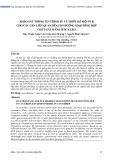
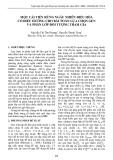
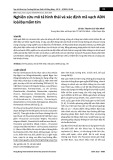
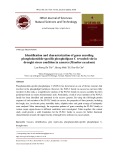
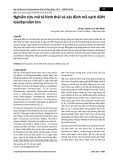




![Bài giảng Giáp xác chân mái chèo [mới nhất]](https://cdn.tailieu.vn/images/document/thumbnail/2025/20250927/lethihongthuy2402@gmail.com/135x160/92891759114976.jpg)



![Tài liệu học tập Chuyên đề tế bào [mới nhất]](https://cdn.tailieu.vn/images/document/thumbnail/2025/20250906/huutuan0/135x160/56151757299182.jpg)






